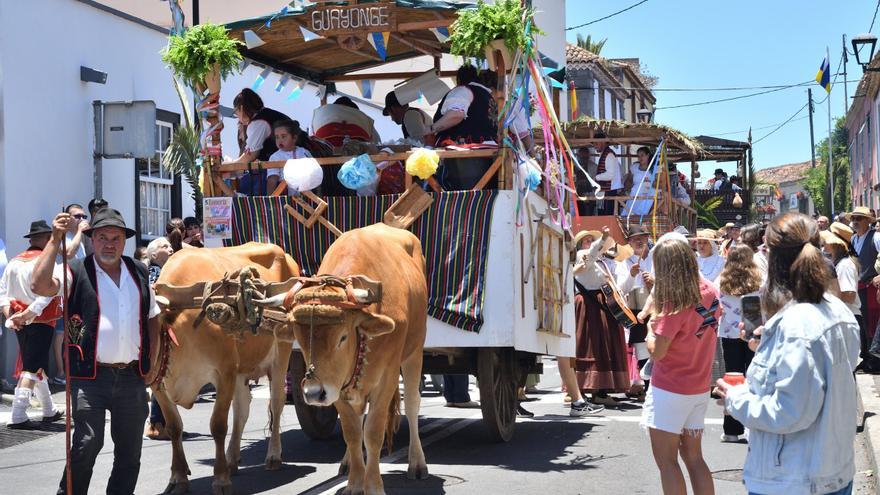
Tacoronte reunited with its rural past and folklore essence last Sunday. The XXXIII edition of the Pilgrimage in honour of San Isidro Labrador allowed the municipality, which has an unbreakable bond with the countryside, to take a step back in time and pay tribute to the agricultural and livestock past that all pilgrimages honour. And, as usual in these cases, it was an opportunity for festivity, fun, and hedonism…
The first sign that the celebration was a success was the scene on the road towards Tejina, with a full shoulder where parking seemed impossible. The weather was pleasant, with bright sunshine, and the event coincided with the beginning of summer. In the area of La Alhóndiga, after 2:00 p.m., the scene was full of celebration, and it had not yet – or at least not noticeably – taken the downward turn that most pilgrimages tend to experience.
“I’m having a great time. I’ve been coming for years because I have family here and because it’s become a tradition to come,” explained María Luisa, an attendee who had travelled from the town of Santa Cruz to Tacoronte to enjoy the pilgrimage. She was accompanied by her daughter, son-in-law, grandchildren, and other relatives. “A week ago, we agreed and decided to come together,” she expressed.
The event followed the traditional route between the Santa Catalina parish and La Alhóndiga. It started at 12:00 p.m. with the Eucharistic celebration, officiated by the parish priest Elisuán Delgado and sung by the Folkloric and Cultural Group Guarache. The pilgrimage then began. The City Council had announced it as “massive”, and it was. It involved 25 carts and around twenty folk groups and musical bands from different parts of the island.
“This has always been a great celebration. I remember 20 or 30 years ago when people came from all over, and people from all over still come. I have a couple of friends who always call me around this time and usually stop by my house. This ultimately is an opportunity to meet up,” said Juan Antonio, a resident of Tacoronte who described himself as a “big follower of pilgrimages”.
The pilgrimage parade in this municipality concludes the festive programme of these dates, “highlighted by the traditional music of the Islands and nods to local livestock farming“, as emphasized by the City Council. Over 5,000 people, according to municipal sources, joined the pilgrimage route this year, with 25 carts and around thirty folklore groups, bands, families from different locations.
The procession was led by a dozen horses, a herd of goats, and the ribbon dance group of the A.C. El Candil, and the Realejo group La Guanchería. Behind them was the saint, guarded by the ecclesiastical and civil authorities of the municipality. The Mayoress, Sandra Izquierdo; the deputy mayors Noemí García and José Caro; the Culture councillor of the Tenerife Island Council, José Carlos Acha, and the regional deputy Rebeca Paniagua were some of the public figures present.
“The public encountered a wide range of traditional island music, accompanied by dances from a diverse group of performers who, for the most part, enjoyed the day while respecting the appropriate attire for the occasion, along with the local wine, traditional nougat, and grilled meat. This was highlighted in the statement sent by the City Council after the event on Sunday, which concludes this year’s programme, “coordinated by a security operation involving personnel from Tacoronte Local Police, Civil Guard, Canary Islands Police, Civil Protection, and Spanish Red Cross”.
Vibrant Atmosphere in the Streets
It is worth mentioning that the decoration once again featured colourful flags and ornamented staffs with colourful ribbons. Additionally, the carts displayed products donated by the Tacoronte Farmer’s Market, distributed typical food items, and emphasised the island’s livestock tradition, thanks to the presence of twenty-five yokes and around fifty industry professionals.
“The organisation successfully managed to celebrate the route that connects each year the pedestrian area of Santa Catalina with El Calvario de Tacoronte, next to the emblematic La Alhóndiga building,” expressed the City Council, before adding that “the pilgrimage once again circled back at this point in the historic centre to then return to the outskirts of the town’s patron church, where the eagerly anticipated popular open-air dance took place”. This final gathering, a usual ending to pilgrimages, was enlivened by the Dinacord orchestra and La Calle Group.
















